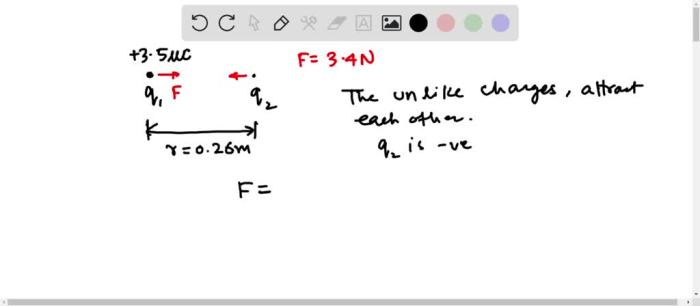In a vacuum two particles have charges of, delving into the captivating realm of electrostatics, where particles acquire charges and interact in a unique environment devoid of matter. This article unravels the intricacies of electrostatic charges in a vacuum, exploring their types, interactions, and practical applications.
The presence of electrostatic charges in a vacuum challenges our understanding of electrical phenomena, revealing the fundamental properties of matter and energy. As we embark on this journey, we will uncover the mechanisms that govern charge separation and accumulation, delve into the dynamics of electrostatic discharge, and explore the diverse applications where electrostatic charges in a vacuum play a pivotal role.
Electrostatic Charge in a Vacuum

In a vacuum, electrostatic charge refers to the presence of an electric field around a particle due to an imbalance of electric charges. This imbalance can occur when electrons are removed from or added to an atom or molecule, creating a charged particle.
Examples of particles that can acquire electrostatic charge in a vacuum include protons, electrons, and ions.
Electrostatic charge in a vacuum requires the absence of any conducting medium, such as air or metal, to allow the charge to flow away. In such an environment, charged particles can retain their charge for extended periods, leading to the accumulation of electrostatic charge.
Types of Electrostatic Charges
In a vacuum, particles can have two types of electrostatic charges:
- Positive charge:Occurs when a particle has a deficiency of electrons, resulting in an excess of protons.
- Negative charge:Occurs when a particle has an excess of electrons compared to protons.
The magnitude of the charge is determined by the number of excess or deficient electrons, and the sign of the charge indicates whether it is positive or negative.
Charge Separation and Accumulation, In a vacuum two particles have charges of
Electrostatic charge separation and accumulation in a vacuum can occur through various processes, including:
- Triboelectric charging:Contact and separation of dissimilar materials can transfer electrons, resulting in the accumulation of opposite charges on the surfaces.
- Induction charging:A charged object can induce an opposite charge in a nearby neutral object without physical contact.
- Field emission:In strong electric fields, electrons can be emitted from a surface, leaving behind a positive charge.
Charge separation and accumulation can have significant effects on the behavior of particles in a vacuum, influencing their trajectories and interactions.
Electrostatic Discharge in a Vacuum
Electrostatic discharge (ESD) in a vacuum occurs when accumulated electrostatic charge is released suddenly. This can happen when charged particles come into contact with a grounded surface or another charged object.
ESD in a vacuum can have several consequences:
- Damage to sensitive electronic components:High-energy ESD can damage or destroy electronic devices.
- Generation of electromagnetic interference (EMI):ESD can create electromagnetic pulses that can interfere with electronic systems.
- Ignition of flammable materials:ESD can generate sparks that can ignite flammable materials in vacuum environments.
Applications of Electrostatic Charges in a Vacuum
Electrostatic charges in a vacuum find applications in various fields:
- Particle accelerators:Electrostatic fields are used to accelerate charged particles to high energies.
- Electron microscopy:Electrostatic lenses focus electron beams to create magnified images of samples.
- Ion implantation:Electrostatic fields are used to implant ions into materials to modify their properties.
- Electrostatic precipitators:Electrostatic charges are used to remove particulate matter from air and other gases.
Understanding and controlling electrostatic charges in a vacuum is crucial for the safe and effective operation of various technologies.
Expert Answers: In A Vacuum Two Particles Have Charges Of
What are the different types of electrostatic charges that particles can have in a vacuum?
Particles in a vacuum can acquire either positive or negative electrostatic charges. Positive charges arise from a deficiency of electrons, while negative charges result from an excess of electrons.
How does charge separation occur in a vacuum?
Charge separation in a vacuum can occur through various mechanisms, such as friction, contact electrification, and induction. These processes involve the transfer or redistribution of electrons between particles, resulting in the accumulation of opposite charges.
What are the potential applications of electrostatic charges in a vacuum?
Electrostatic charges in a vacuum find applications in diverse fields, including particle accelerators, electron microscopy, and electrostatic propulsion systems for spacecraft. They also play a crucial role in understanding the behavior of plasmas and other charged particle environments.

